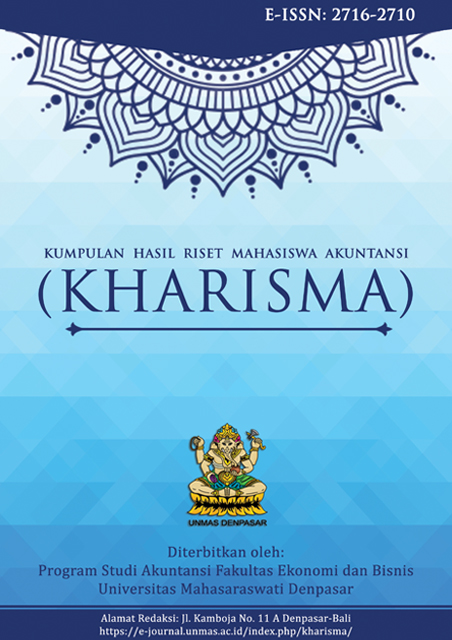Pengaruh Human Capital, Structural Capital, dan Customer Capital terhadap Kinerja Perusahaan Sektor Food and Beverage di Bursa Efek Indonesia
Keywords:
Human Capital Efficieny, Structural Capital Efficieny, Customer Capital Efficiency, Firm PerformanceAbstract
This study aims to analyze the effect of Human Capital Efficiency (HCE), Structural Capital Efficiency (SCE), and Customer Capital Efficiency (CCE) on the performance of Food and Beverage sector companies listed on the Indonesia Stock Exchange (IDX) during the 2019–2023 period. A quantitative approach was employed using multiple linear regression analysis. The sample consisted of 16 companies selected through purposive sampling. The results indicate that HCE has a significant negative effect on firm performance, SCE has no significant effect, while CCE has a significant positive effect on firm performance. These findings suggest that intellectual capital management, particularly in the customer relationship dimension, plays a crucial role in improving company performance and competitiveness.
References
Barney, J. (1991). Firm resources and sustained competitive advantage. Journal of Management, 17(1), 99–120. https://doi.org/10.1177/01492063910170010
Bontis, N. (1998). Intellectual capital: An exploratory study that develops measures and models. Management Decision, 36(2), 63–76. https://doi.org/10.1108/00251749810204142
Bontis, N., Keow, W. C. C., & Richardson, S. (2000). Intellectual capital and business performance in Malaysian industries. Journal of Intellectual Capital, 1(1), 85–100.
Dewi, S. P. (2019). Faktor-faktor yang mempengaruhi kinerja perusahaan manufaktur di Bursa Efek Indonesia. Jurnal Akuntansi dan Bisnis, 4(2), 101–113.
Eliana, S. (2017). Pengaruh intellectual capital terhadap kinerja perusahaan manufaktur di BEI. Jurnal Ekonomi dan Bisnis, 5(1), 45–57.
Ghosh, S., & Mondal, A. (2009). Indian software and pharmaceutical sector IC and financial performance. Journal of Intellectual Capital, 10(3), 369–388.
Kafidin, M. (2020). Analisis pengaruh human capital dan structural capital terhadap kinerja perusahaan manufaktur di Indonesia. Jurnal Riset Akuntansi Multiparadigma, 11(2), 212–226.
Kamaruddin, & S., L. (2022). Pengaruh intellectual capital terhadap kinerja keuangan pada perusahaan manufaktur di Bursa Efek Indonesia. Jurnal Akuntansi dan Keuangan Indonesia, 19(1), 43–55.
Labally, A., Sulastri, D., & Gunawan, E. (2023). Pengaruh human capital, structural capital, dan customer capital terhadap kinerja perusahaan. Jurnal Ekonomi dan Manajemen Bisnis, 8(3), 152–165.
Mariani, L., & Supriyadi, R. (2021). The role of customer capital in improving company value: Evidence from Indonesian consumer goods sector. Asian Journal of Business and Management, 9(2), 99–109.
Muzakki, K. (2020). Analisis pengaruh human capital dan structural capital terhadap kinerja perusahaan. Jurnal Akuntansi Kontemporer, 6(1), 78–89.
Pulic, A. (1998). Measuring the performance of intellectual potential in knowledge economy. Croatian Economic Review, 2(3), 65–76.
Riahi-Belkaoui, A. (2003). Intellectual capital and firm performance of US multinational firms. Journal of Intellectual Capital, 4(2), 215–226.
Stewart, T. A. (1997). Intellectual capital: The new wealth of organizations. Doubleday.
Sofyani, H., & Rizki, M. (2019). Hubungan antara modal intelektual dan kinerja perusahaan di sektor manufaktur Indonesia. Jurnal Ilmiah Akuntansi dan Bisnis, 14(1), 55–67.
Sudirman, N., & Hartati, D. (2020). Human capital and organizational performance: The mediating role of innovation capability. Journal of Business Research, 10(3), 122–137.
Sugiyono. (2018). Metode penelitian kuantitatif, kualitatif, dan R&D. Bandung: Alfabeta.
Sveiby, K. E. (1997). The new organizational wealth: Managing and measuring knowledge-based assets. Berrett-Koehler.
Victoria, M., & M. N. (2020). Pengaruh intellectual capital terhadap kinerja perusahaan manufaktur di Bursa Efek Indonesia. Jurnal Ilmu Akuntansi dan Keuangan, 8(2), 75–88.
Yunus, M., & Sari, I. (2021). Intellectual capital and firm performance: Empirical evidence from ASEAN countries. International Journal of Economics and Management, 15(1), 44–59.
Downloads
Published
Issue
Section
License

This work is licensed under a Creative Commons Attribution-ShareAlike 4.0 International License.



